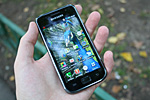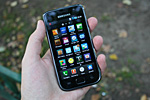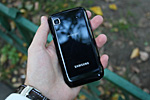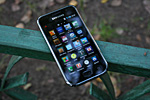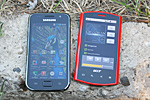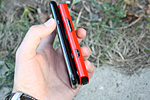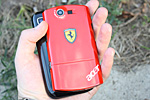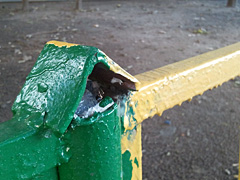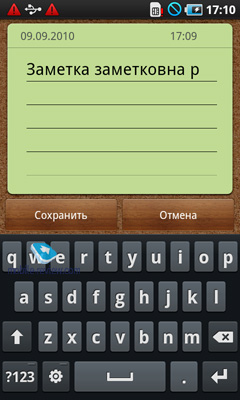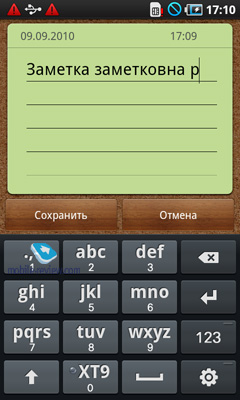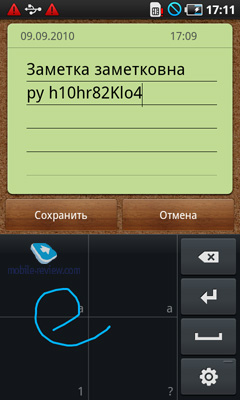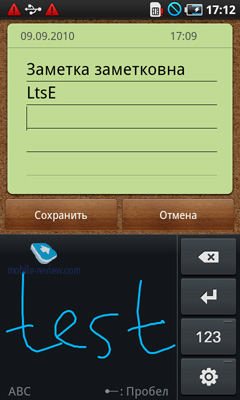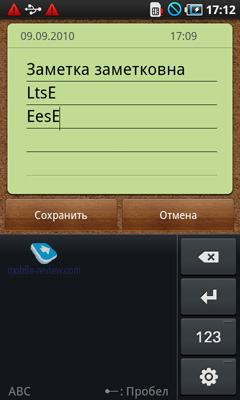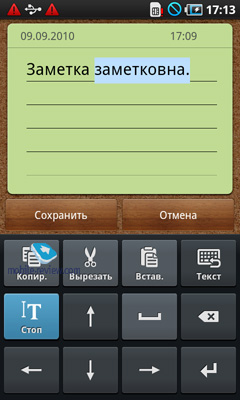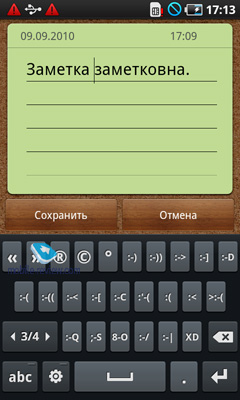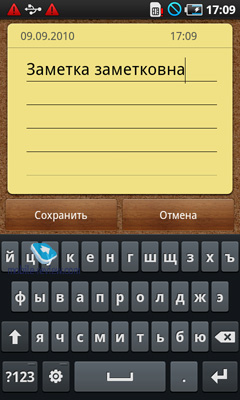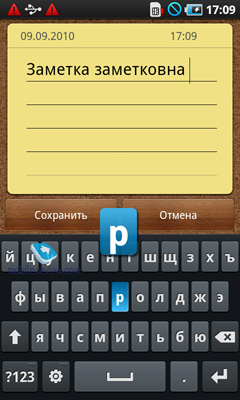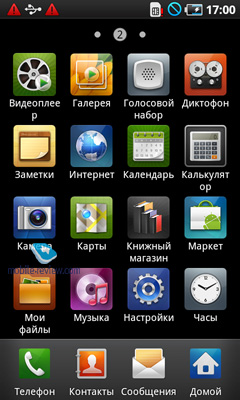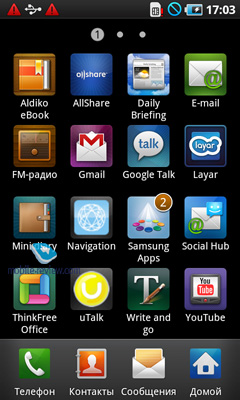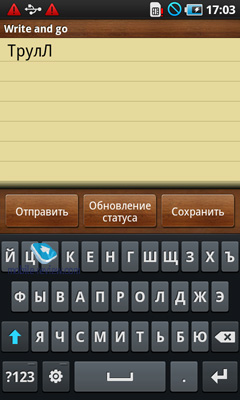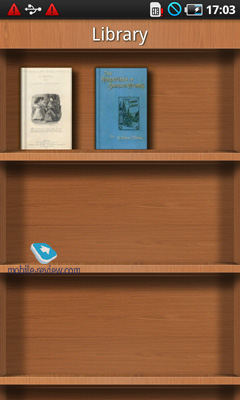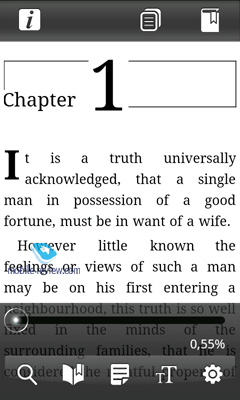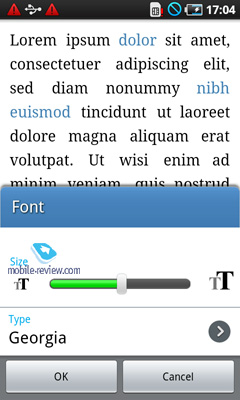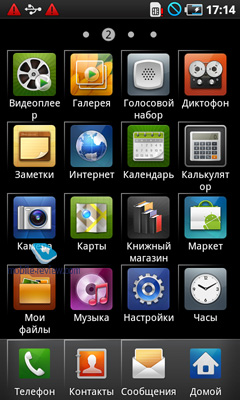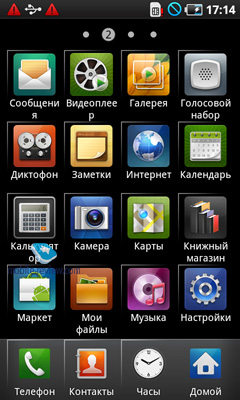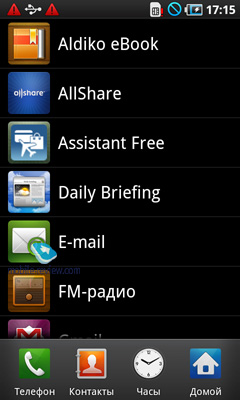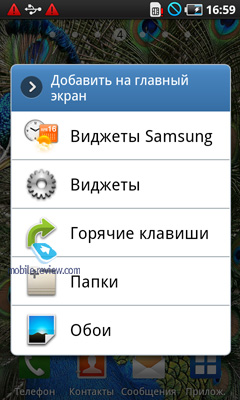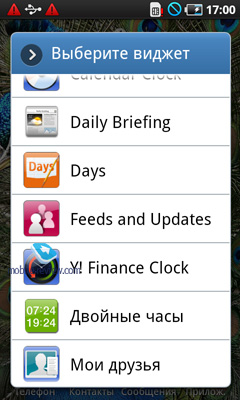Review of the Samsung Galaxy S GSM/UMTS Smartphone
Live Images of the Samsung Galaxy S
Contents:
- Positioning
- Materials and Design
- Dimensions
- Controls
- Display
- Camera
- Video
- Battery Life
- Performance
- Interfaces
- Navigation
- Text input
- Software
- Conclusion
Before we get to the actual smartphone, I would like to present my apologies to the readers for the serious delay of this article; there are both objective and not so objective reasons for that. Let's begin now.
There are two materials about the Samsung Galaxy S on our website already: my thoughts about the device right after its announcement and Eldar Murtazin's detailed first look. Those two articles can provide you with a fairly good feedback on the device and therefore I am not going into details in this review but will rather describe what the Galaxy S feels like in reality after some several weeks of heavy use.
HTC EVO 4G and Samsung Galaxy S
Positioning
From the announcement and early sales to these days, when the device is (temporarily) discontinued, its positioning hasn't changed. It is Samsung's top Android, a flagship and simply one of the most technologically advanced smartphone in the segment. Among the features that define its positioning are the Super Amoled screen, 1 GHz processor, standalone graphics chip, etc. Nearly each and every latest technology, including software, from the Korean company is being used in the device.

Back to the table of contents >>>
Materials and Design
My personal impression of the majority of Samsung devices can be described as follows: they leave me absolutely indifferent. To some extent, that is probably my personal issue, but on the other hand it is also the company that hasn't been putting much effort into the product design, which makes Samsung devices predominantly unemotional and, in my opinion, indistinguishable from each other. I don't know whether it is a good or bad thing for a top smartphone, but the Galaxy S is an embodiment of a boring design to me.
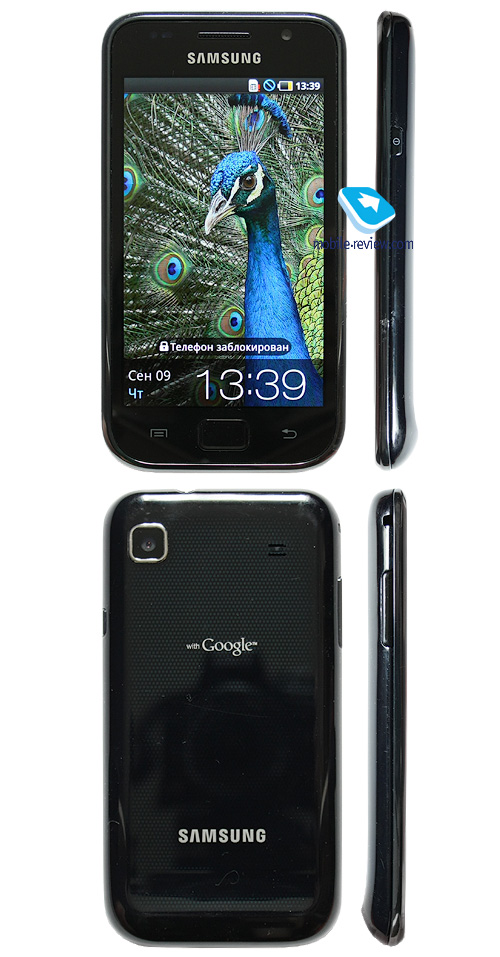
The device is made of glossy plastic and has a chrome-plated plastic frame on the front panel. The battery cover is made of patterned plastic. Altogether, the materials make the smartphone feel as a cheapo handset, and the low weight only exacerbates the general impression. If it were a bit heavier, the weight sensation could compensate for the inexpensive materials, but it's not there.

The rear panel gets soiled easily albeit the fingerprints are hardly visible. The real problem is that it wears out very quickly, becomes covered with a lot of tiny scratches and abrasion, and will appear shabby in a matter of weeks. To help alleviate the problem, you may want to use a protective case or try to handle the smartphone with extra care. The screen is a fingerprint magnet, but that is a common issue with touch-sensitive phones.


To the extent that my eyesight is okay, the smartphone color is dark blue. The battery cover appears different in various lighting conditions; it is dark blue under direct sunlight and black if it's dark.

The build quality is good, there are no complaints there. After a two weeks use, the device remains solid and without any flex.
Back to the table of contents >>>
Dimensions
In terms of dimensions, the Galaxy S is comparable to the Apple iPhone 4 and HTC Desire, but I would even dare compare it to the HTC HD2, which is somewhat narrower but taller.
- Samsung Galaxy S – 122.4 x 64.2 x 9.9 mm, 119 grams;
- HTC HD2 – 120.5 x 67 x 11 mm, 157 grams;
- Sony Ericsson X10 – 119 x 63 x 13 mm, 135 grams;
- HTC Desire – 119 x 60 x 12 m, 135 grams;
- Apple iPhone 3GS – 115.5 x 58.6 x 9.3 mm, 137 grams.

Although the device dimensions appear large on paper, in reality it doesn't feel that bulky in one's hand. That is, if you compare how the Galaxy S and, say, HTC HD2 feel, then the latter appears gigantic whereas the former feels like a regular smartphone that is handy and comfortable to hold during long phone conversations. By the way, the fact that it's lightweight is important, too. You can carry the S in your pants or jeans pocket as it is slim enough to go virtually anywhere.




Back to the table of contents >>>
Controls
As far as its controls are concerned, the Samsung Galaxy S is quite simple. It has three buttons below the screen – i.e. Menu, Confirm and Back, a volume rocker on the left and a screen lock key on the right side. The central button below the screen is an actual hardware one, whereas the ones on its left and right are sensor keys.


In general, many users (including myself) tend to think that the button below the screen is actually a sensor panel when they see the smartphone for the first time. The thing is that Samsung uses a touchpad, which looks just like that, quite often. However, in case of the Galaxy S, it is just a button.
Having had some experience with HTC and Acer devices, I did miss the Search key in the Galaxy S a lot. Naturally, there is always a software search button available around, but the majority of "robots" are equipped with a dedicated, at least sensor, key.
The volume rocker is handy, there are no complaints there. As far as the screen lock key is concerned, those users who are used to it being on the top may find its location in the Galaxy S somewhat awkward. On the other hand, the rest should like the key being on the side. In a word, it's just a matter of one's prior experience.


At the top of the front panel, there is a speaker with grille protection. To the left of it you can find light and proximity sensors. To the right, there is a VGA camera lens. There is no indicator light in the smartphone, not a single one. In my opinion, discarding indicator lights is as stupid and unjustified a manufacturer tradition as that of discarding hardware camera buttons. At some point, HTC stopped installing camera buttons on its devices but appears to have reconsidered that now. I hope that the same will be true for Samsung and the hardware camera key as well light indicators will be back in some future models. Anyway, you will have to turn on the screen on your Samsung Galaxy S to check for any missed calls or new messages or to simply make sure that the smartphone is still working.

Some users will be glad to learn that the smartphone has a lanyard hook. You can find it on the left side slightly above the volume rocker. On the top, there is a microUSB port with a protective lid for charging and data transfers. The 3.5 mm audio jack is located nearby.
Quite unexpectedly, the Samsung Galaxy S features an unusual and, in my opinion, unjustified way of working with the audio jack. Any contemporary smartphone allows you to connect either a headset or a pair of headphones. In both cases that doesn't prevent you from talking on the phone. If a headset is connected, all the sound goes in an out through it, whereas if headphones are connected, then you use them to hear what the other side has to say and the phone microphone to say something in response. If you like some headphones very much and use them to listen to the music, why not use them to talk on the phone as well? If you connect headphones, not a headset, to the Samsung Galaxy S, you won't be able to hear the other side in them as the sound will go directly through the speaker. What is this limitation for?
The SIM card and memory card slots are located beneath the battery cover but in such a way that you can't take a SIM card out of the slot unless the battery is removed. The memory card slot is hot swappable, though.

Back to the table of contents >>>
Display
The device sports a Super AMOLED screen from Samsung. It is 4 inches wide, has a resolution of 800x480 pixels (WVGA) and allows for up to 16 million colors. The viewing angles are maximal, and the screen has a gigantic contrast ratio and brightness and remains readable even in direct sunlight.

The display type is capacitive, and you can use multitouch both in the main menu to display the matrix of desktops and in various applications: e.g. Google maps, browser, picture gallery. The screen is covered with glass, which won't stand severe abuse but will provide enough protection from accidental scratches from keys and other sharp objects.
And now I would like to add some subjectivity, if you please. My firm belief is that the Super AMOLED and alike won't stick around for a long time. And that is not due to the facts that the company is experiencing problems with its mass production and that its power consumption is very high. The thing is that a common hi-res TFT screen with a quality picture is simply easy on the eyes for most users, and that is not true for the Super AMOLED. There are people who like the latter's excessive contrast and brightness even on the lowest levels, but there also exist those who simply can't get used to that. Hence I can't say that the display in the Galaxy S is one of the best. It offers the best contrast and maximal image sharpness indeed, but in my opinion those are outrageous and that is what makes the screen questionable.
Camera
The smartphone is equipped with a 5-megapixel camera with autofocus. The camera lens is in the upper left corner of the rear panel, flush with the battery cover. If the device sits on the table with its battery cover facing downwards most of the time, the camera lens is sure to attract some scratches, so you'd better be careful about that.
In the viewfinder mode, there are two informational columns displayed (at the left and right sides of the screen) – e.g. chosen presets, shooting mode, current resolution and how many more shots you can make. For additional options, you need to tap on the icon in the lower left corner of the screen.
The list of supported resolutions is as follows:
- 2560x1920
- 2560x1536
- 2040x1536
- 2048x1232
- 1600x1200
- 1600x960
- And less
You can also change the image quality, shooting mode and other options in the preferences menu.
I am not going to get into details as to whether the camera in the Samsung Galaxy S is good or bad. Every reader can make their own decisions by taking a look at the sample pictures below. However, I would like to say the following: objectively, if one compares the pictures taken with the Samsung Galaxy S, HTC Desire, HTC Legend, Acer Liquid E and a number of other most recent Android devices, then the S appears to be the winner. The pictures are not ideal, but still the best you can get in the segment and the difference is quite apparent. That is, one can say that the Samsung Galaxy S has one of the best cameras among the "robots." By the way, the same is also true for video recording.
Back to the table of contents >>>
Video
Motion video is recorded in the 3GP format (H264 codec) at a rate of 30 frames per second.
The list of supported resolutions is as follows:
- 1280x720
- 720x480
- 640x480
- 320x240
- 176x144
All video recording options are identical to those available for the still image mode. You can also use zooming while recording. You can get an idea of the video quality by taking a look at the sample clips below.
Sample Videos 1 (3gp, 89,8 mb) >>>
Sample Videos 2 (3gp, 12 mb) >>>
Back to the table of contents >>>
Battery Life
The device is equipped with a 1500 mAh Li-Ion battery. The producer claims up to 13.5 hours of talk time (GSM) or up to 750 hours (30 days) of standby. The real results are at least two times lower than that, though

Under a typical usage scenario (i.e. 30-40 minutes of daily phone conversations, 10-15 text messages, active Gmail and MS Exchange Server accounts with push-mail) my unit could last for a day and a half on average. If you add some Web browsing (1-2 hours) and music playback (3-4 hours), the battery life will drop to just one day. In any case, those are good results when compared to HTC devices (e.g. the Desire). The smartphone will definitely last for at least one day; you won't have to recharge it the car on your way back home or unplug it from the mains outlet right before leaving in the morning to ensure that it's fully charged and won't die in the middle of your day (consider that a dig at the latest HTC devices).
Back to the table of contents >>>
Performance
The smartphone is built on Samsung S5PC100 (ARM8 Cortex) platform with a 1 GHz processor and PowerVR SGX540 graphic coprocessor. Until recently the company has not used this platform, but now you can find it in Galaxy S and Galaxy Tab. By the way, this platform will feature in Meizu M9, which I personally await with great interest (follow the news at).
The model has 512 MB of RAM and 8/16 GB for data storage. Regarding the video playback I have to say that during its announcement the following supported formats were mentioned: Mpeg4, H.264, H.263, H263Sorenson, DivX/ XviD, VC-1, 3gp (mp4), WMV (asf), AVI (divx), MKV (container) and FLV. Clearly, the manufacturer planned to offer the best "robot" for video playback. Samsung did not fail to deliver and the handset indeed plays videos, series and movies in all popular formats with any resolution up to 720p.
I had no complaints towards the overall performance speed during the two weeks I tested the smartphone. I cannot say that all applications were fast as lightning, but it was comfortable to work with and can be compared to HTC Desire in this respect. Besides, I am definitely a lucky user, because now when the model has been already on sale for some time we see that Samsung Galaxy S has some performance related issues.
I will not describe the issue and the appropriate solution named lagfix in detail here. Those who came across it are already in the know. If you like you can read about the problem here. I did not have any particular slowdowns in my sample.
Back to the table of contents >>>
Interfaces
The smartphone operates in GSM (850/900/1800/1900) and UMTS (900/1900/2100) networks. Both EDGE and HSDPA are supported. Different communication modules can be enabled and disabled in the settings menu or via the system bar, which can be dragged at the top. This feature has been thoroughly thought over and all interfaces can be accessed from the bar and one touch is enough to add or delete any of them.
To synchronize with a PC and transfer data you will need a microUSB cable from the box (USB 2.0). When you connect to the computer one of several connection types can be selected, including data transfer (microSD card and internal memory are visible) and synchronization with a PC.
The in-built Bluetooth 3.0 supports the following modules:
- Audio/Video Remote Control Profile (AVRCP) – control of music playback from a wireless headset.
- Generic Audio/Video Distribution Profile (GAVDP)
- Audio/Video Distribution Transport Protocol (AVDTP)
- Advanced Audio Distribution Profile (A2DP) – stereo sound transfer via Bluetooth
- Hands-Free Profile 1.5
- Human Interface Device (HID)
- File Transfer Profile (FTP)
- Object Push Profile (OPP)
The music quality in wireless headphones is decent.
WiFi (802.11b/g/n). WiFi worked ideally. In the smartphone you can customize rules for the WiFi sleeping mode, use only static IP addresses during the connection and add security certificates. When WiFi is used the smartphone barely warms up and is a step forward in this respect in comparison with, let's say, HTC HD2, which becomes quite warm with active WiFi. Apart from that Galaxy S supports DLNA.
Back to the table of contents >>>
Navigation
Samsung Galaxy S features an in-built GPS chip. The cold start requires around one minute and a half and then the satellite search takes 10-20 seconds (we tested it with Maverick app from the Market). To my mind the satellite signal reception is on par with its rivals and other "robots".
Navigation is assisted by two apps. The first one is Google Maps, which allows routes plotting (without voice prompts), search for addresses by street names or locations (restaurants, cafes, institutions). Its advantage over more serious navigation software is that maps are downloaded from the web and technically you can access all international cities of note. You just have to stay online, which is the main disadvantage of Google Maps as it becomes useless without the internet connection.
The second application is Navifon, which is good in ordinary phones where you cannot use fully functional navigation apps and its presence in Samsung Galaxy S is strange, but it is better than nothing.
Back to the table of contents >>>
Text input
In Samsung Galaxy S the text input can be carried out through a popular Swype keypad. What is it? In the world of screen keypads Swype for Android is like Natural Ergonomic Keyboard 4000 for blind typing. In other words Swype has it all, but it is still not the most convenient keypad for Android. Especially when you start using Russian and the letters seem narrow and difficult to touch correctly at least from the start. You have to get accustomed.
Another downside is a complicated languages switch. The latest Swype version has a key for the languages switch, but on the majority of Galaxy S handsets you have to do the following: go to settings, choose Languages and select a required language from the list, confirm your selection and you are done. Fast, isn't it? In fact you can do it easier. Just move a finger up from the "Information" (i) key, but how can you learn about it by simply using the phone? On first pages in the Swype help section it is not mentioned and you only have to guess.
Among advantages of Swype I have to mention the fast speed of input, once you get accustomed to it. The keypad has tons of settings for ideal customization. Capital letters, automatic spacing and sound/vibration can be easily configured among other things.
Back to the table of contents >>>
Software
The smartphone boasts Android 2.1 and TouchWiz interface. I will not describe all interface features of Galaxy S, but would like to highlight key advantages and disadvantages. We'll start from the positive.
The smartphone has a lot of additional apps. Some people complain that too many applications make it difficult to navigate. At the same time Galaxy S has a useful preinstalled app for reading books, beautiful note taking app, travelers' companion and RSS reader. Moreover, it is one of the first Android smartphones with the preinstalled files manager, which HTC products unfortunately cannot offer. The majority of apps cannot be uninstalled, but Samsung Galaxy S has acres of space.
The model sports a dictaphone, calculator with the engineering mode and several other utilities.
Now let's mention the drawbacks. The main one is the far from ideal localization of the dialer and interface in the phonebook. In HTC smartphones I test there is often no Cyrillic bar to scroll in the phonebook. Nevertheless, this feature stays in engineering and test samples, while the consumers get Russian in this bar. Galaxy S has no Russian in contacts scrolling bar even in the commercial version. The same applies to the dialer.
Drawback No 2. Inexplicably, developers decided to get rid of all standard Android widgets. Some may think it is a trifle, but it is not so. I believe that Samsung developed widgets have been in stagnation for several years and Galaxy S widgets are slightly useless. The main complaint is the impossibility to choose widget sizes - they are either full screen or half screen. If on any other Android smartphone I drag a clock widget and can place there up to 10 apps icons in Galaxy S the solitary widget takes up the lion's share of the screen. Other mini apps are the same.
Back to the table of contents >>>
Conclusion
During the testing I never had any complaints about the signal reception or volume of both the speaker and the loudspeaker in Samsung Galaxy S. The sound is powerful and you can miss the call only in particularly noisy environment. The vibro is average and I missed it at times.
At the beginning of October Samsung Galaxy S cost around $930, but you can easily buy uncertified samples for $600-630, so the gap is huge. Uncertified Galaxy S is similarly priced to uncertified HTC Desire, but the gadget from Samsung has a bigger screen, better camera and the in-built memory for data. HTC Desire has a more convenient shell (I will repeat it again and again), optic trackball for menu navigation and more compact body coupled with higher capability to work from the box to make and receive calls, messages and e-mails.
Every Samsung flagship I tested and reviewed was controversial for me in its own way. It happened both with Samsung i900 (WiTu) and Samsung i8000 (WiTu 2). At the same time I knew that these models were absolute hits despite all minor complaints. Samsung Galaxy S is a bit different– despite all its advantages there are obvious downsides as well: inexpensive materials and overall physical experience, not the easiest keypad to adapt and incomplete localization. For the current price Galaxy S is still one of the leading Android solutions even if you need time to come to terms with it.
Back to the table of contents >>>
Description:
- Class: smartphone
- Form factor: candybar
- Rivals: HTC Desire, Sony Ericsson X10
- Body materials: matte plastic, metal
- Operating system: Android 2.1
- Networks: GSM/EDGE 850/900/1800/1900 MHz, UMTS/HSDPA 900/2100
- Processor: Samsung S5PC100 (ARM8 Cortex), 1 GHz
- RAM: 512 MB
- User memory: 8/16 GB + microSD memory card slot
- Interfaces: Wi-Fi b/g/n, Bluetooth 3.0 +EDR (A2DP), microUSB (USB 2.0) for charging/synchronization, 3.5 mm headset jack
- Display: capacitive, Super AMOLED 4″ with WVGA resolution (800x480), automatic backlight adjustment
- Camera: 5 MP with autofocus, video recording in 720p
- Navigation: GPS/A-GPS
- Additional features: FM radio, accelerometer, light sensor, proximity sensor
- Battery: attachable 1500 mAh Li-Ion battery
- Dimensions: 122,4 x 64,2 x 9,9 mm (4.81″ x 2.52″ x 0.38″)
- Weight: 119 g (4.19 oz).
Back to the table of contents >>>
Artem Lutfullin ([email protected])
 Twitter Twitter
Translated by Maxim Antonenko ([email protected]), Olexandr Nikolaychuk ([email protected])
Published — 14 October 2010
Have something to add?! Write us... [email protected]
|
